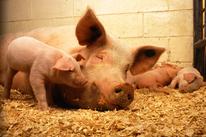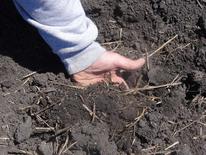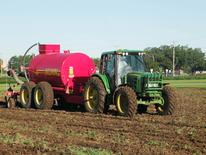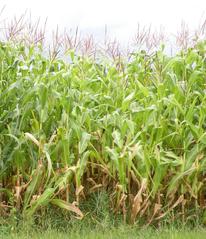By Constance Carlson
Edited by Kristine Moncada, Craig Sheaffer, Gigi DiGiacomo and Nicole Tautges
Craig Mathews* grew up on a farm in west central Minnesota in the 1940s and 1950s, but left farming to pursue a teaching degree. He met his wife Stephanie, started teaching and then moved back to his hometown to continue teaching. On the day he was supposed to report to graduate school, Craig went into town and purchased the farmland where he farms today. He had been eyeing it for months for many reasons, but perhaps most importantly, because it was conveniently located near his father’s farm. When it came to deciding between teaching and farming, Craig chose farming.
Nearly from the moment they purchased the farm, the Mathews knew that they wanted to be good stewards of the land. In the early 1970s, Craig and Stephanie chose to farm organically partly because they didn’t have the start-up money and resources to pay for the seed and inputs required to farm conventionally. Craig witnessed farming practices in his childhood that didn’t require chemical inputs, so he knew it could be done. Craig and Stephanie were also aware of the ecological impact their decisions had on their farm’s land and natural resources and this is another big reason why they had chosen to use organic farming practices.
The Mathews’ farm grew to be a diverse enterprise of 300 acres that included commodity grain crops and a 300-head farrow-to-finishing indoor hog operation. Stephanie worked full-time off the farm and, with Craig, raised four children who assisted in the farm operations, including managing the livestock, picking rocks, pulling weeds and other manual labor required in organic production systems.
The Mathews became officially certified as organic in the mid-1990s. Compared to many growers who faced a challenging transition; the switch to organic standards was relatively easy because they had been following organic practices for many years. Craig paid close attention to soil conservation and maintained a regular rotation of corn-soybean-small grain with red clover underseeded in the small grain. This rotation, he found, worked well within his organic system. It improved the soil, captured nutrients, added nitrogen and suppressed weeds and pests. In addition, small grains provided marketing flexibility—Craig would vary the small grain he planted depending on what grain was commanding the best price. Some years, he underseeded the small grains with alfalfa instead of red clover (e.g., corn-soybean-small grain/alfalfa-alfalfa) to harvest a hay crop, and on occasion he experimented with field peas and dry beans to also fix nitrogen and provide a source of green manure.
Craig’s operation ran for several decades as a system that maximized the nutrients available within his operation. The hog manure provided needed nutrients for his field crops and he raised a portion of his field crops to be fed back to the livestock. At the same time, a percentage of both his livestock and crops were marketed. To produce competitive yields in corn, farmers need to replace the nitrogen that the crop removed from the soil. Conventional farmers have an arsenal of synthetic fertilizers to choose from, but certified organic farmers do not. Eventually, Craig found his system produced crops that had “county competitive yields,” meaning, his organic crops were yielding comparably to his conventional counterparts. This was important to Craig’s farming philosophy and his bottom line.
Organic Farming is Always Evolving
In the late nineties, Craig and Stephanie’s last child left the farm for college. Around the same time, the market prices for hogs were depressed and were forcing operators to scale up toward larger and larger production, with operations ranging around 3000-5000 head. It was becoming increasingly difficult for small-to-midsize hog operations like Craig’s to make a profit. Craig knew it was important to have livestock for many reasons. The manure produced by hogs was an ideal source of added nutrients for his organic field crops because it had no added cost, it was approved by organic certifiers, readily available, and easy to spread. Also, hogs provided diversity to his operations so he wasn’t reliant solely on his commodity grains for farm income.
After many discussions with Craig’s brother and his nephew, both of whom had farm operations near Craig, the men decided they would consolidate their hog operations. Craig’s brother would manage the breeding stock, his nephew would manage the farrowing (birthing) operations and Craig would manage the finishing. In this new business arrangement, the farmers retained the livestock and manure, but spread out the costs and the labor.
Craig and his family ran the swine operation in this way for about fifteen years, but the market prices and operation size never stabilized enough for the Mathews’ operation to be sustainable. Craig and his family came to realize they did not have the resources to expand their operation to raise the hog numbers needed to be viable in the pork industry. Finally, the hard decision to cease livestock operations was made.
The decision to cease livestock production had almost immediate ramifications on Craig’s crop production. The first year without manure inputs from his farm, Craig’s noticed his corn was slower to germinate and lacked the vigor it needed early in the season to compete with weeds. Craig knew, through years of experience, that his corn crop would continue to show a decrease in yield without additional N inputs.
The next year, Craig’s rotation happened to allow him to leave corn out, but he knew he was at a critical crossroads at his farm. Nitrogen was an immediate concern, but phosphorus was a long-term concern. Alfalfa was important to the rotation for the N, but because he harvested and sold it, he knew the alfalfa would deplete his soil of phosphorus in the long-term. This would have a detrimental effect on soybean yield. This was the year he needed to formulate a new plan for nitrogen and phosphorous inputs. Where would Craig get the nutrients he needed to grow competitive yields?
Craig also looked at alternative, organic-approved inputs, such as composted pelletized turkey litter. The pellets provided a source of nitrogen and phosphorus and would fall within the requirements for organic certification. However, Craig found that he would need a considerable amount of litter to replace the nutrient needs in his soil, because the pellets have a low nutrient concentration. The pellet fertilizer was labeled as 5-5-5 (NPK) meaning that it contained only 5% of nitrogen, phosphorus (P2O5), and potassium (K2O).
He also found the pellets were frustrating to manage. He had to find a way to have them transported to his farm and then he didn’t have the equipment to accurately or effectively spread the pellets on his fields. Inputs such as this were an added expense, with prices ranging up to $125/ton and between two to three tons/acre might be needed. Would the hassle and expense provide the results Craig needed to continue to grow corn and soybeans?
Another option Craig considered was buying manure. He knew that there were no organic livestock operators near enough, but maybe there was a conventional neighbor with manure to sell. Organic certification does not require the farmer to have an organic source for manure. Craig was familiar with the National Organic Program (NOP) standards on manure because of his use of his own manure through the years. Manure is considered a restricted input and therefore has requirements for application. Manure may only be used in conjunction with other soil-building practices and application rates must be less than or equal to the requirements of the crop.
In addition, the organic farmer must have the manure tested to ensure that it does not contain non-approved synthetic additives. All of this information was tracked and reported to his certifier every year. This paperwork is also required if manure is purchased or brought onto the farm from non-organic source. Craig was concerned that the added cost of buying, hauling and applying the manure would outweigh the return from the corn crop. It was important to have a source close enough to have cost effective hauling costs. The cost of manure would be about $90/acre if he could find a nearby source, but manure from a farther source would be significantly more.
Craig knew that this was the year to make critical decisions about his organic operation. He estimated his corn yield would be reduced by 50 bushels/acre (from 160 to 110 bushels/acre) without the use of manure or a commercial fertilizer. If he couldn’t find an effective solution for managing the fertility and nutrients in his soil for competitive organic yields, there was a real chance that Craig would have to accept a significant decline in farm revenue or, even more drastically, have to discontinue farming organically. Should Craig buy manure? Should he invest in animal production again? Or should he quit certified organic production altogether?
* While this case describes an actual situation, names have been changed to protect the identity of participants.
Access the complete decision case study with all educational materials (pdf) >>>
You may cite this publication as:
Carlson, C. 2017. Finding Fertility without Livestock. A Decision Case Study in Principles for Transitioning to Organic Farming: e-Learning Materials and Decision Case Studies for Educators. K. Moncada, C. Sheaffer, G. DiGiacomo, and N. Tautges (Eds). University of Minnesota, St. Paul, MN.




